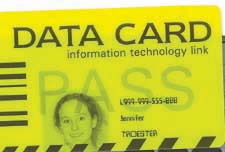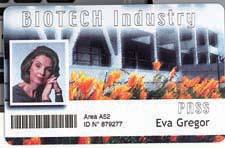Outwitting Card Forgers

While high quality scanners, printers and low-cost personal computers (PCs) make it easier to forge cards, security must constantly look to more advanced methods to protect their companies, employees and customers. Layered security procedures built into card design offer unique opportunities to elevate security with minimal cost. Sometimes protecting a card’s integrity begins with the very ink being used to print the card. Color-shifting inks, like those used on the new $20 bill, can thwart color copying. Specialized inks only visible with infrared and black light readers provide an unseen layer of protection. Although not an ink, laser engraving can burn tamperproof, unique variables onto a card.

Multiple color security
Micro-printing words or phrases, undetectable except under close examination, also are offered by specialized card manufacturers. Guilloche printing, which employs a secure, computer-generated multiple-color complex design, can be integrated with existing artwork to create a unique background impossible to reproduce. Burying graphics only visible with a high intensity light inside the lamination layers, called hidden print, is yet another option. New advances in two-dimensional bar coding often are overlooked but allow much information to be encoded on a card creating new levels of security. Companies specializing in card manufacturing also can use diffused or ghost imaging, which prints two, slightly overlaid images or text on a card, making card duplication very difficult for the casual forger. Holograms, virtually impossible for scanners to replicate, also can be printed directly on the surface or imbedded as background patterns under the laminate film.Ensuring the validity of a signature will often foil a card thief. By using tamper-evident signature panels such as a Pantograph multicolor pattern, or printing signature surfaces that degrade if physical or chemical tampering is attempted, the secure link between a cardholder and his signature can be ensured. Fingerprint-receptive surfaces can be added to further prevent card fraud.
The actual materials used to make a card also can increase its integrity. Contrasting colored plastics laminated together give the card a unique profile when viewed edge-wise. Additionally, the card manufacturer can print the card around a super opaque-colored core that is only detectable with special readers. Even switching from traditional brown magnetic stripes to colored stripes adds to the uniqueness of a card and can be used to signify different security clearances.
These printing techniques and advanced materials stand well as cost effective, proven security measures and can ensure additional levels of layered security, fraud protection and privacy for your cardholders.
Looking for a reprint of this article?
From high-res PDFs to custom plaques, order your copy today!




